
Guests
- Charlotte Canshead of photography for the United Nations Office for the Coordination of Humanitarian Affairs.
The Gaza Collective Photo Essay project, organized by the United Nations Office for the Coordination of Humanitarian Affairs (OCHA), collected work from 14 Palestinian photographers who were each asked to share one image that captured the devastation of the Gaza Strip over the last six months. We speak with Charlotte Cans, head of photography at OCHA, about the project. “It’s one thing to say there’s a war and it’s horrible, and it’s another thing to see an image of a child being pulled out from the rubble. It really hits you differently,” Cans says of the motivation behind the project. “It was really important to elevate the stories coming from Palestinian photojournalists, who are the only window into what is going on in Gaza.”
Transcript
AMY GOODMAN: This is Democracy Now!, democracynow.org, The War and Peace Report. I’m Amy Goodman.
On Thursday, I spoke with Charlotte Cans, head of photography for the United Nations Office for the Coordination of Humanitarian Affairs, OCHA, about the Gaza Collective Photo Essay project she has led. She asked 14 Palestinian photographers to share one image taken in the Gaza Strip over the last six months that they want the world never to forget. A warning to our TV audience: The interview features graphic images. She speaks from Paris, France.
CHARLOTTE CANS: Thank you very much, Amy, for having me and having us and talking about this project, which is very special indeed.
I think, you know, the first thing is that a couple of weeks into the war, the U.N. Secretary-General António Guterres said the situation in Gaza is not just a humanitarian crisis, it’s a crisis of humanity. And I think, for me, for us, this is what, you know, started it all, because the assault that we’re seeing on the population of Gaza is unprecedented in brutality, scope and intensity. And the figures speak for themselves. In six months, you had over 100,000 people killed and wounded, 70% of whom are children and women. You know, this staggering number, as well, that the number of children killed in Gaza is higher — in six months, is higher than the number of children killed in four years of all the wars combined all around the world. You have three-quarters of the population displaced. Famine is imminent. Law and order are breaking down. Humanitarian aid is actively blocked, and on and on and on. And, you know, I think these figures are so staggering that they defy comprehension. And so, for me, and for us, it was really important to try to humanize these numbers, to make them real and to make them understandable.
And I think it’s quite paradoxical, because there’s been an overflow of images and stories on Gaza, flooding our phones, flooding our screens, you know, for six months, but somehow, somehow, it is — it is not getting across. And I could see it in my direct environment, you know, talking to friends and families. I could see that people didn’t really understand what was going on in Gaza. Yes, they know there’s a war in Gaza, and they know that wars are bad and horrible. But it’s one thing to say there’s a war and it’s horrible, and it’s another thing to see an image of a child being pulled out from the rubble. It really hits you differently.
And so, I think, for us, it was really — as the U.N., as OCHA, which is the humanitarian arm of the U.N., it was really important to elevate these stories coming from Palestinian photojournalists, who are the only window into what is going on in Gaza, because, as you know, international foreign journalists have been banned of entering Gaza independently. None of them have, except from Clarissa Ward, who went in for like two hours at the end of sometime in December. So, Palestinian photojournalists are the only ones, are the only window into the suffering of people in Gaza. And so it was really important for us to go to them and to try to share and elevate again the incredible, tragic testimonies that they are reporting and covering, day in, day out, for the last six months.
AMY GOODMAN: So, Charlotte Cans, can you talk about how you reached out to Palestinian photojournalists?
CHARLOTTE CANS: Yeah, that’s a really good question, because it’s been incredibly difficult. It’s been a process that has been going on for weeks. It took us over three months to put this project together. And, you know, as you know, the communications have been really, really difficult with Gaza. I think, you know, it got better recently, but in December, January, up until February, there were like constant blackouts. So it was hard to get a hold of people. And you would get a hold of someone, and then the person would not be responding for days on end. And suddenly you had, you know, an answer, and they were like, “Yes, I’m really happy to participate. I will send you images,” and then nothing again for a couple of days. So it was this constant back-and-forth.
And I just want to say here that, you know, the way we made it happen also has been through an incredible photojournalist called Tanya Habjouqa, who’s been based in Jerusalem, Ramallah for the past 25 years. Tanya is an award-winning photojournalist. She knows the country and the region inside out. And she had an incredible networks of, you know, colleagues, Palestinian colleagues. And so, through Tanya, as well, we were really able to reach out to a number of them, bring them on board. And, you know, it was a combination of, again, her network, word of mouth. And also, Amy, to be honest, you know, they are being killed also, Palestinian photojournalists, so there are not that many of them left in Gaza, to be honest, and this is tragic.
AMY GOODMAN: So, introduce us to some of the photographs that are in this collection.
CHARLOTTE CANS: OK. So, I think — let me actually — I’m just taking it in front of me. I think, you know, there’s one photo for me that hits me really hard. It’s the photo from photographer Jehad Al Shrafii [@jehad_alshrafi]. Jehad is a 22-year-old Palestinian photographer from Gaza. And he took this image of Ibrahim, who’s a 12-year-old boy, like any other boy in the world, who had his arm amputated because of his injuries in the last six months. And we can see him, on the image, trying to brush his teeth. And he’s holding the toothbrush with his mouth and the paste, the toothpaste, in his left hand. And he’s trying to do something as simple as brushing his teeth. And you can see in this image how difficult it is and how his life has been turned upside down.
And I think, you know, with the number of children killed in Gaza and wounded — and I think, again, this is pretty unprecedented compared to other conflicts and wars around the world, you know. And when we say — I think it’s Save the Children, had this terrible statistic a few months ago, which was that 10 children per day, on average, have lost an arm or a limb in the war. And when you see that, when you see Ibrahim trying to brush his teeth, you understand what that means. It’s his life has — his life has been shattered. But it’s not just his life. It’s his family’s life, as well, because he will need a caregiver for years to come. So, again, it’s like, you know, through the war, it’s entire families who are being affected. And I think this image really hits, you know, very hard to me.
AMY GOODMAN: Charlotte, introduce us to Belal Khaled [@belalkh] and his picture.
CHARLOTTE CANS: Yeah. So, Belal is a very interesting, you know, character and person. He used to be a calligraphy artist, and he is still a kind of calligraphy artist, but he was, you know, making a living as a calligraphy artist also before the war. He’s also a photojournalist. He’s an incredible photographer. His images are stunningly tragic, very often.
There’s a couple of images of him in the project. One of them is of a little boy who is, Amy, the color of ashes. He’s sitting on a hospital bed crying, and there’s blood dripping along his face. And Belal, in the text that accompanies the photo — because that’s something very special to this project. It’s not just the images. It’s the personal texts that the photographers have shared to accompany the images, where they explain their emotions and the backstory to the image and what the story means to them. And Belal has these words with this image. He says that this child, when he got to hospital, was crying for his bicycle. And he kept saying that he wanted his bicycle, he wanted his bicycle, not having fully comprehended what had just, you know, hit him. So, this is a really strong image.
There’s another one from Belal, which is incredibly strong, as well, where you see a family. And I think this is very special, because in many images that we’ve seen on Gaza, quite often it’s one parent or the other with their dead child, but in this image you see the entire family. You see the mother, you see the father, you see the brother, and you see this dead child in their arms. And their grief and their suffering is so raw in this image. It’s incredibly strong.
AMY GOODMAN: I wanted to read the quote that Belal Khaled sent. He said, “A Palestinian child was carried to al-Nasser Hospital, pulled out from rubble. At the hospital his aunt recognized him and started screaming his name. 'This is Diya'a, this is Diya’a…’. When his siblings, mother and father arrived, their pain was unforgettable. He had left their home to get some wood for heat when he was killed in an airstrike.” The family forms a cocoon around his shrouded small body. Tell us about the photographer Jehan Kawera [@jehan_kawaree].
CHARLOTTE CANS: So, Jehan is a young female photographer. There’s a couple of them in the project. We have three female photographers represented, with Jehan, Mariam Abu Dagga [ @mariam_abu_dagga] and Samar Abu Elouf [@samarabuelouf]. So there’s three of them.
Jehan has this poignant image of a young girl who’s lying on a hospital floor. It’s a very graphic image. It’s very hard. You can see the hands of a health specialist trying to, you know, fix something, her drip, or whatever that is. But what is striking in this image is that she’s got her right hand lying on the floor, and in her right hand, there’s a piece of candy. And it’s this, you know, typical candy that kids in many different places of the world eat that is very recognizable. And seeing this young girl, this — she’s probably 6 or 7, no more, lying on the floor with a piece of candy in her hand.
And the quote, again, of Jehan is incredibly, incredibly powerful. And I have it in front of me, actually, Amy. I don’t know if I can read it to you. But she says that she could not hold herself up when she saw this little girl “gasping for breath, and the piece of candy, still stuck in her hand stained with blood.” She “will never forget when she was carried to the mortuary.” And she says here, “The candy fell at my feet on the blood-soaked ground.”
And again, I think what is so strong with this project, again, is that these images hit you because they make this suffering so relatable. These are not just random kids. When you recognize the piece of candy in her hand, you can see all the kids that you know, your own kids, your nephews, your nieces. And that makes it, again, particularly strong.
AMY GOODMAN: Can you tell us about Saher Alghorra [@saher_alghorra]?
CHARLOTTE CANS: Yes. So, Saher has an incredible image in the project where you see a dad — it’s in a white tent — screaming. And the dad is in a bit of a hallucinatory state, as he says himself in his text. And right next to him lying on the floor is the body of his dead child, covered by white cloth. And Saher has been documenting the war for the last six months for many different outlets. He’s a really strong photographer. He just won Picture of the Year, actually, for his work. And again, you know, this image is — the suffering is so raw and so eerie. Yeah, it’s just — it just hits you, you know, directly. It just stabs you in the heart, really, Amy.
AMY GOODMAN: And then there’s Mahmud Hams [@mahmudhams]. It’s similar, but different. He says, “Mohamed El-Aloul is a cameraman for Anadolu news agency. He is my friend. We spend a lot time together, and we also often cover the war together. Four of his children were killed in an airstrike. His wife was severely injured. When he heard what happened to his family, it was early morning, and we were together at the hospital. We went to the morgue at Al Alqsa. I knew his children. All I could do was to be there, with him, crying.”
CHARLOTTE CANS: Yeah, absolutely. Mahmud is a photographer for AFP, Agence France-Presse, who’s been covering 30 years of war in Gaza. And I think this image is very strong, as you say, Amy, because it talks about, you know, the fact that, again, these Palestinian photojournalists are being killed in this war. And they are not just witnesses. They are victims, as well, whether they are being killed or wounded or whether they are being displaced with their families. And this, again, makes it very, very special in, you know, what we’re seeing unfolding in Gaza right now.
AMY GOODMAN: And what you know of Mohamed El-Aloul, the cameraman who lost his children? He’s wearing — of course, he’s wearing the press vest.
CHARLOTTE CANS: Yeah, exactly. And I think in this incident where the house where he was staying in got targeted by an airstrike, he lost three of his children and his brother on the strike. So, again, we’re talking about entire families being detonated.
AMY GOODMAN: And Anadolu news agency, where is it?
CHARLOTTE CANS: So, Anadolu is a Turkish news agency. It’s one of the big news agencies, again, based, headquartered in Turkey.
AMY GOODMAN: Tell us about Mohammed Zaanoun [@m.z.gaza].
CHARLOTTE CANS: So, Mohammed Zaanoun is also one of the, you know, main photojournalists who’s been reporting on this war since the beginning. He’s working for several news agencies. He’s working — you know, he’s been working for Al Jazeera. He’s been working for Le Monde. He’s been working for several, for a couple of others.
His images are all very striking. There’s a couple in the project. There’s one of where you can only see the feet of a child, and you only see that it’s tiny feet in the photo — you don’t know who it is — completely buried under the rubble. And Mohammed has this caption, which says, “A child’s feet were all that were visible from the rubble. The little girl was killed along with three of her brothers by an Israeli air strike in Khan Yunis market. The mother, she lived, but was hopeful for hours that they would be pulled out alive by the paramedics, from the rubble where her home once stood.”
And I think this photo is incredible, Amy, as well, because, you know, it’s probably — again, when people have seen them, it’s one which really stayed with them. It’s graphic in a way, but it’s not graphic in another. But the emotion that you have when you see this image, again, you know, very strong, and it makes you understand, again, what we were talking about before: What does this war look like, day in, day out, for people and families and children in Gaza? You know, seeing a child’s feet under the rubble, you know, again, makes you understand the war quite differently than just reading about it.
AMY GOODMAN: Charlotte Cans, head of photography for OCHA, the United Nations Office for the Coordination of Humanitarian Affairs. She coordinated the Gaza Collective Photo Essay project. Charlotte said these are not just photojournalists; these are also civilians. They’re witnesses and victims to the horrible conflict that we’re seeing unfolding in front of our eyes. We particularly thank Charlotte for this interview. She was in Paris after the passing of her mother this week.
And that does it for our broadcast. Democracy Now! is currently accepting applications for our digital fellowship. Learn more and apply at democracynow.org.
Democracy Now! is produced with Renée Feltz, Mike Burke, Deena Guzder, Sharif Abdel Kouddous, Messiah Rhodes, Nermeen Shaikh, María Taracena, Tami Woronoff, Charina Nadura, Sam Alcoff, Tey-Marie Astudillo, John Hamilton, Robby Karran, Hany Massoud. I’m Amy Goodman. Thanks for joining us.

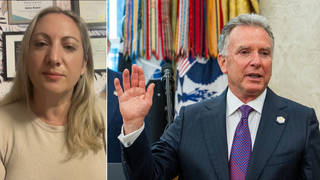
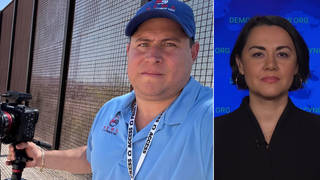
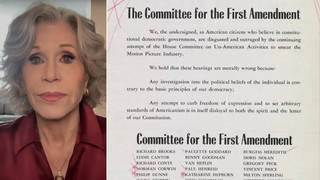
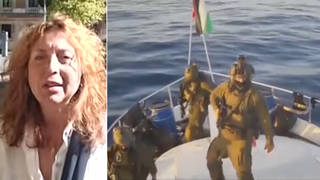

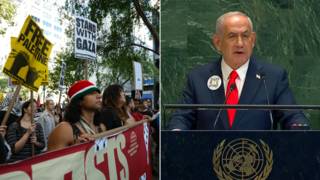
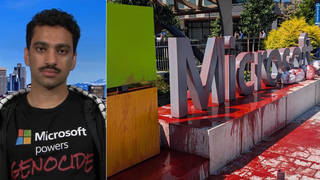
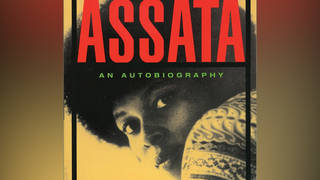

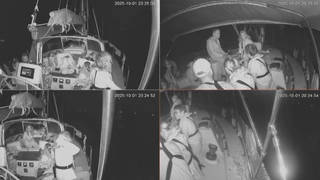
Media Options